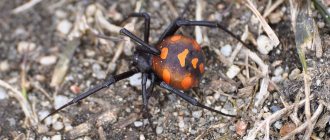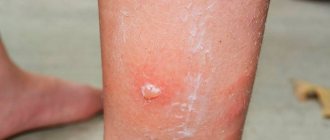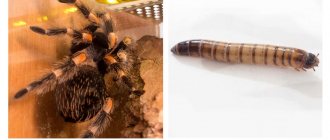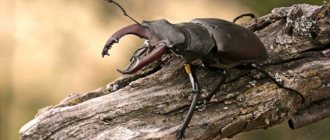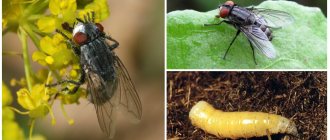Description of spiders
Spiders have 8 legs. The body is divided into 2 parts, they are connected by a thin stalk. Most spiders have 8 eyes, some have 6. A few arachnids outside Europe have 4 or 2 eyes. Spiders' eyes do not have one location; it depends on the species. Some spiders have the same size eyes, others have different ones. Most spiders have poor vision. But some species have large front eyes with fairly good vision:
The easiest way to determine whether an arachnid is male or female is to look at the front tentacles. In females they are quite narrow; in spiders, the tips of the tentacles resemble boxing gloves. Males use them as pipettes to release sperm during mating.
Which spiders are endemic to Russia and Europe, the most common species
The most famous and dangerous spiders in Russia
Over 1 thousand species of spiders live in Russia. Some are quite often found in residential areas and their proximity does not pose a threat, others can be seen exclusively in the wild, but it is advisable to avoid contact with them. The full list of them is quite large and therefore today we will focus only on a few - we will talk about those who really deserve attention. What are they - the most famous, large and dangerous spiders in Russia?
Harmless species
Hunter bordered
A spider of swamps and swamps, it always lives close to water; the semi-aquatic species has an intriguing hunting technique. It detects slight vibrations produced by insects or other creatures, runs along the surface of the water, and grabs prey.
Body length up to 2.2 cm, paw span about 7 cm - this is the largest spider in Russia. The arachnids are brown in color, with a characteristic pale stripe running from the head down the sides of the thick, cigar-shaped body.
Flower spider
It has a short, wide, flat body. The first two pairs of paws are larger than the hind ones and are widely spaced to make it easier to hold prey. Females are from 6 to 9 mm in length, males from 3 to 4 mm. The female is light in color: the back and legs are white or yellow with darker sides and reddish markings on the belly. The male is darker: reddish-brown with a white patch above the eyes. These colors are variable and spiders change color according to the flower they live on. Both sexes have small, venomous fangs for hunting insects.
House spider
The length of the female is from 9 to 10 mm, the male is from 6 to 9 mm. The spiders are quite large and hairy, with long legs, and the color ranges from pale to dark brown. The abdominal cavity has variable soot markings. Males have a slimmer abdomen than females and longer legs. Males are seen more often than females, they are the ones wandering around the house in search of a partner. Once a spider has discovered a female's web, it will stay with her for several weeks, mating with her multiple times during that time. Then he dies, and the female eats the body; nutrients are needed for the development of the offspring.
Knitting spiders
They live in bushes and meadows, especially if they are near a water source. Long-jawed weaver spiders build circular webs, usually parallel to the ground over ponds or streams. Males and females weave webs, but when males reach sexual maturity, they move onto the webs of other spiders, especially females, where they hunt:
- flies;
- ants;
- aphids
Knitting spiders are slender creatures with long legs. They stretch and align their bodies on flower stems, camouflaging themselves from predators. Their sizes range from half to more than a centimeter, depending on the species.
South Russian tarantula
A rather large, usually brown spider, but the color varies depending on the habitat. He has 8 eyes, two of them are large, the rest are the same size. If light shines into the eyes, they glow. There is a distinct violin-shaped marking on the head. The bite is not fatal, but causes an allergic reaction in sensitive people.
Poisonous spiders
Karakurt
The black spider has a shiny body; juvenile and adult males of the species have 13 spots on their back. Males have creamy white spots, while young females have red (sometimes yellow or orange) spots. All adult females are black. Karakurts rarely come indoors, preferring grassy areas and especially hot, dry areas such as coastal dunes. They build webs close to the ground, in abandoned rodent burrows and under rocks and logs. The male karakurt stops feeding before mating and consequently dies of hunger.
Cross spiders
There are many types of crosses, they differ:
- shape;
- size;
- color.
Typically the species is 2 to 3 cm in length (females) and 1.5 to 2 cm (males). Most species are reddish brown or gray with leaf-shaped patterns on thick, triangular-shaped abdomens, and also have two prominent humps at the front. Cross spiders sometimes have a white or brown dorsal stripe with a white edge.
Hyracantidae
The upper abdomen has a dark, spear-shaped mark that runs down the middle of the abdomen from the point where the thorax and abdomen meet to about the middle of the abdomen.
The color ranges from light beige to yellow, often with a hint of green. The tips of the paws are dark brown.
These are nocturnal hunters who search for prey rather than catch it in a net. Spiders come into contact with humans if they get between the skin and sheets, clothing or shoes. They will also bite if provoked by a person while working in the garden or habitat.
Chiracantida bites are painful and the venom damages the skin, causing:
- slow healing wounds;
- itching;
- edema.
These bites are not considered medically dangerous.
Black Widow
It is a shiny, round black spider with a red hourglass mark on its ventral side (belly). There is also a red or orange spot above the spinnerets. This is the typical appearance of a female.
Male black widows are much smaller than females, with elongated purple, gray or black bodies, white ventral stripes and red, yellow or orange spots. Juvenile females are rounder than males, but have similar coloring and markings.
Body size of black widows: females from 8 to 13 mm, males from 3 to 6 mm. The paws are proportional to the body.
Brazilian wandering spider
Recluse spider
Spider sak (yellow heyracantium)
Photos and names of the most prominent representatives
You can meet spiders everywhere among vegetation. They live in holes underground, tree hollows, on the grass, and often enter the house through open windows, doors, and cracks in the wall. A person is not attacked without a threat to his own life. After a spider bite, an allergic reaction of varying degrees of intensity occurs.
Karakurt
Poisonous spiders of the Samara region in the southern regions, a type of black widow. They are large in size - up to 20 mm. Males are always smaller than females. The coloring varies, in Samara it is a bright black predator with red spots all over the abdomen and cephalothorax. The limbs are black, long, powerful, tenacious. The main habitats are wastelands, slopes of ravines, virgin lands, and banks of reservoirs.
Spiders live in burrows that they build underground. Trap nets are formed at the entrance. To lay eggs, a cocoon is constructed from spider webs. In this state, the embryos overwinter and continue to develop in the spring.
The karakurt bites in defense, defending its own life. The poison disrupts the functioning of the nervous system, causing muscle spasms, difficulty breathing, rapid heartbeat, increased blood pressure, and convulsions. Swelling, swelling, redness, and pain remain at the site of the bite. The situation requires immediate medical attention, otherwise the person risks dying. Karakurt bites are especially dangerous for children, the elderly, with an increased tendency to allergies and pathologically weak immunity.
Black fathead and karakurt
Black fathead
Bright spiders in Samara have an unusual color. The male is more attractive, although the female is slightly larger. The body length reaches 2 cm. The cephalothorax and paws are velvety and black.
Lives in a hole that it builds underground; the labyrinths reach up to 50 cm deep. The entrance is protected by cobwebs. Prefers to hunt passively. Sits in a hole, waiting for the victim to fall into the web. It feeds on insects, loves beetles, and does not disdain flies. Found in forests, fields, wastelands, loves sunny glades.
The poison is extremely toxic to insects and causes local irritation in mammals and humans. Bite marks disappear gradually over the course of a week. To accelerate the therapeutic effect, antihistamines are used.
Plant hunter (Dolomedes plantarius)
Common types of spiders in the Samara region. There are 4 species living throughout the region. The striped hunter is listed in the Red Book. The body size of females is about 2 cm, males are half that size. The abdomen is elongated, oval. Colors beige, brown, gray. All over the body there are patterns in the form of stripes and spots.
Hunters live near bodies of water and prefer a humid climate. They run quickly on land, chasing prey on the water, constructing a raft from available materials - leaves, sticks, twigs. The predator stays afloat as long as it needs. It feeds on terrestrial and aquatic insects and larvae. They reproduce rapidly, with one clutch containing 600 eggs.
Plant hunter and tarantula
South Russian tarantula
Spiders dangerous to humans in the Saratov region are listed in the Red Book. They are related to wolf spiders, found in the wild, but often crawl into the house. They lead a nomadic lifestyle and actively hunt at night. They feed on insects, beetles, and small relatives. They run fast and jump 15 cm in height.
Description of appearance - brown, beige, ash, large with powerful long limbs. On the abdomen, cephalothorax, and paws there are patterns that are slightly different in color from the main range.
The bite of a tarantula is compared to the bite of a bee, wasp, or hornet. Instantly pain, swelling, swelling, and redness appear. A deterioration in general well-being occurs with an increased tendency to allergies, as well as in young children.
In addition to these representatives of the family, the Samara region is inhabited by hay spiders, cross spiders, house spiders, side walkers, spitters, canopy spiders, silver spiders, and wall atipus.
Medium poisonous spiders
banana spider
Giant tree spider
goldweaver
Tarantula
Spider wasp (Argiope brunnich)
Females are larger (especially in late summer, before eggs are laid), and the thorax is brightly colored with yellow, black and white stripes, reminiscent of a wasp. Males are tiny and do not look like females. Weaving webs in high meadows. The network is characteristic, with an obvious zigzag pattern. As a rule, they feed on grasshoppers and other insects caught in the net.
